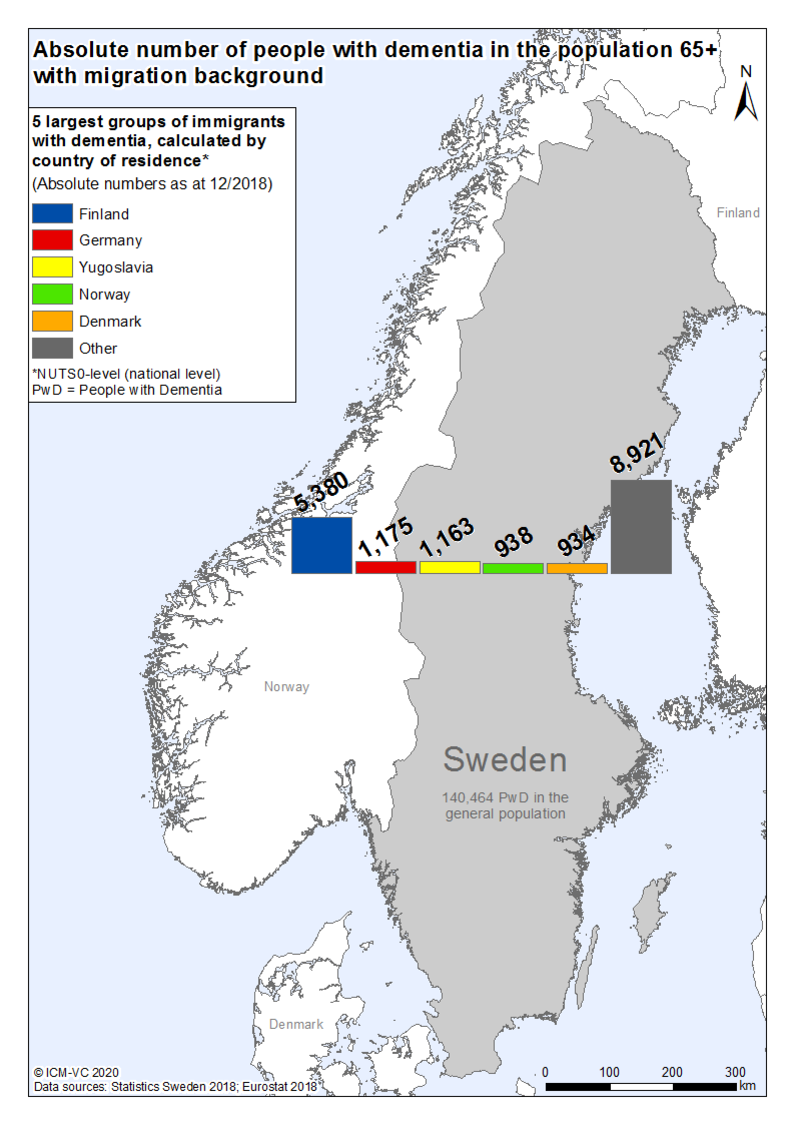EU-Atlas: Dementia & Migration
| Largest group | 2. largest group | 3. largest group | 4. largest group | 5. largest group | |
| Absolute numbers | |||||
| PwMD per 100,000 inhabitants 65+ |
| Absolute numbers | PwMD per 100,000 inhabitants 65+ | |
| Largest group | ||
| 2. largest group | ||
| 3. largest group | ||
| 4. largest group | ||
| 5. largest group |
| Prevalence per 100,000 inhabitants 65+*, calculated by country of residence | |||
|---|---|---|---|
| high > PwMD |
minor > - PwMD |
||
| increased > - PwMD |
low ≤ PwMD | ||
| medium > - PwMD |
|||
| PwMD = People with a Migration background with Dementia *Bulgarien, Litauen, Malta, Polen in der Bevölkerung 60+ |
|||
| Absolute number of PwMD 65+ | |
| PwMD per 100,000 inhabitants 65+ |
Sweden
Sweden has a long history of migration. Through the immigration of about 180,000 refugees from Finland, Norway, Estonia, Denmark, and Germany during the Second World War, Sweden developed into the immigration country it is today. In the 1960s and early 1970s, the government actively recruited labour migrants from the Netherlands, West Germany, Italy, Austria, Belgium, Greece, Yugoslavia, and Turkey. EU accession in 1995 and the EU enlargement rounds in 2004 and 2007 led to a significant increase in immigration1,2. Between 1990 and 2019, the migrant population (born abroad) and their proportion in the total population more than doubled (788,800 to 2 million; 9.2 to 20%)3.
There are 268,300 people with a migration background aged 65 or older. Of those, approx. 18,500 are estimated to exhibit some form of dementia. Calculations show the most affected migrant groups presumably originate from Finland (approx. 5,400), Germany (approx. 1,200), Yugoslavia (approx. 1,200), Norway (approx. 900), and Denmark (approx. 900)4.
The document ‘A National Strategy for Dementia: Documentation and Proposal for a Plan for Prioritized Initiatives by 2022’ (2017) refers to migration in a separate section. There, the increasing need to examine and care for people with dementia who speak a language other than Swedish is emphasized. Besides, the document contains a comprehensive framework for action with recommendations for care planners and service providers as well as references to existing studies, projects, care structures, and care services5. The national guidelines for dementia care from 2017 make only a brief reference to people with different linguistic or cultural backgrounds. The evaluation of the guidelines from 2018 has a separate chapter on migration. This indicates that the topic is becoming increasingly more important at the national level. The national guidelines give general recommendations to municipal healthcare providers and show them concrete options for actions to address the current knowledge and care gaps regarding people with foreign backgrounds with dementia6,7.
According to an expert dementia and migration is only partly considered to be important in Sweden. Existing care services are more suitable and adequate for non-migrants with dementia. However, there are also groups of migrants for whom care is more appropriate (people from Finland/Denmark) because they are better integrated into society and there are fewer barriers.
Culturally sensitive care is partly included in the education of healthcare professionals. The proportion of people with a migration background among professional caregivers is high in outpatient and inpatient care (between 20 and 40%). Overall, the need for culturally sensitive care is not being met by sufficiently qualified professionals.
Family, care provider networks, and migrant organisations have an important role in supporting family caregivers with a migration background. Currently, there are differences in the suitability of existing information resources and support services for these family caregivers. There is a very high need for specialised services providing support and information to family caregivers with a migrant background.
References
- Swedish Institute: Sweden and Migration. [https://sweden.se/migration/]. (2019). Accessed 07 May 2020.
- Parusel B: Länderprofil: Schweden. In.: Institut für Migrationsforschung und Interkulturelle Studien, Bundeszentrale für politische Bildung; 2015.
- International Organization for Migration: Total number of international migrants at mid-year 2019: Sweden; 2019.
- Statistics Sweden: Population by country of birth, age and sex In. Stockholm: Statistics Sweden 2018.
- Socialstyrelsen: En nationell strategi för demenssjukdom: underlag och förslag till plan för prioriterade insatser till år 2022; 2017.
- Socialstyrelsen: Nationella riktlinjer för vård och omsorg vid demenssjukdom: Stöd för styrning och ledning: Socialstyrelsens publikationsservice 2017.
- Socialstyrelsen: Vård och omsorg vid demenssjukdom: Sammanfattning med förbättringsområden: Socialstyrelsen Sverige; 2018.


![[Translate to Englisch:] Logo RBS [Translate to Englisch:] Logo RBS](/fileadmin/_processed_/9/7/csm_RBS_Logo_RGB_0e245a98a4.jpeg)